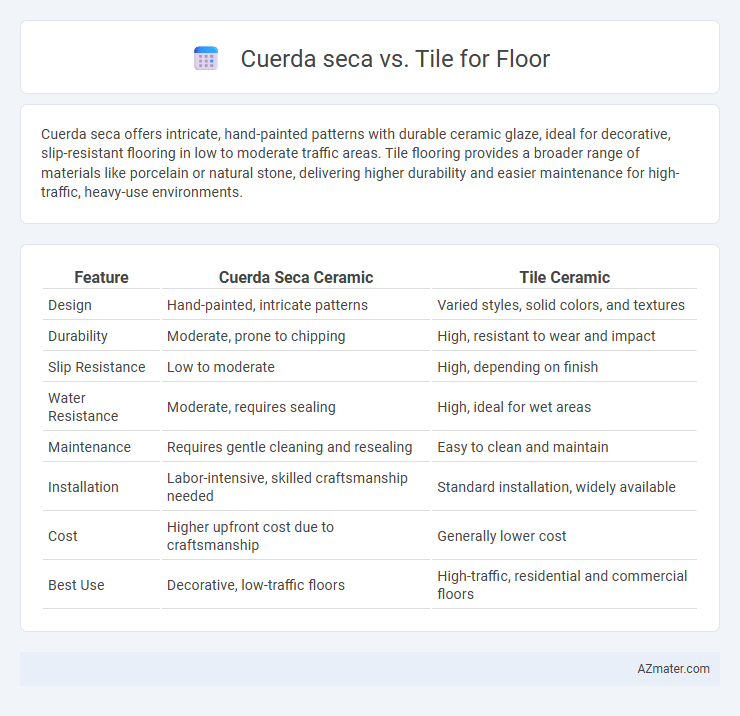Cuerda seca offers intricate, hand-painted patterns with durable ceramic glaze, ideal for decorative, slip-resistant flooring in low to moderate traffic areas. Tile flooring provides a broader range of materials like porcelain or natural stone, delivering higher durability and easier maintenance for high-traffic, heavy-use environments.
Table of Comparison
| Feature | Cuerda Seca Ceramic | Tile Ceramic |
|---|---|---|
| Design | Hand-painted, intricate patterns | Varied styles, solid colors, and textures |
| Durability | Moderate, prone to chipping | High, resistant to wear and impact |
| Slip Resistance | Low to moderate | High, depending on finish |
| Water Resistance | Moderate, requires sealing | High, ideal for wet areas |
| Maintenance | Requires gentle cleaning and resealing | Easy to clean and maintain |
| Installation | Labor-intensive, skilled craftsmanship needed | Standard installation, widely available |
| Cost | Higher upfront cost due to craftsmanship | Generally lower cost |
| Best Use | Decorative, low-traffic floors | High-traffic, residential and commercial floors |
Introduction to Cuerda Seca and Tile Flooring
Cuerda seca is a traditional ceramic technique characterized by bold, separated colors created using a greasy resist to prevent glaze mixing, resulting in intricate, decorative patterns ideal for artistic floor accents. Tile flooring typically consists of ceramic, porcelain, or natural stone tiles offering durability, ease of maintenance, and a wide range of styles suitable for both residential and commercial applications. Choosing between cuerda seca and standard tile flooring depends on aesthetic preferences, functionality, and installation environment.
Historical Background and Origins
Cuerda seca, a ceramic technique originating in 10th-century Islamic Spain, involves using a greasy resist to create vivid, separated colors in tilework, significantly influencing Moorish architectural decoration. In contrast, traditional tile flooring traces back to ancient Mesopotamia and Egypt, where baked clay tiles were utilized primarily for durability and function rather than intricate artistry. Both methods reflect distinct cultural heritages: cuerda seca emphasizes ornamental beauty in Islamic art, while tile flooring broadly serves practical and decorative purposes across various civilizations.
Materials and Manufacturing Processes
Cuerda seca tiles involve a ceramic glazing technique where a greasy resist line separates colored glazes to prevent mixing during firing, resulting in sharp, intricate patterns ideal for decorative flooring. Tile flooring materials typically include porcelain, ceramic, or natural stone, produced through pressing, glazing, and high-temperature kiln firing to ensure durability and uniformity. While cuerda seca focuses on artisanal craftsmanship with layered glazes and controlled kiln processes, standard tile manufacturing emphasizes mass production with consistent quality and varied material compositions.
Visual Appeal and Design Options
Cuerda seca tiles offer intricate, hand-painted patterns with vibrant colors that create unique, artisanal visual appeal, making them ideal for adding artistic focal points in flooring. Tile flooring provides a broader range of design options, including various materials like ceramic, porcelain, and natural stone, allowing for versatile textures, finishes, and contemporary or traditional styles. Both options enhance aesthetic appeal, but cuerda seca stands out for rich, colorful motifs, whereas standard tiles excel in customizable patterns and material diversity.
Durability and Longevity Comparison
Cuerda seca tiles offer strong durability due to their thick glaze layer, which provides excellent resistance to wear and fading, making them ideal for high-traffic areas. Traditional ceramic tiles also provide good longevity but may be more prone to chipping and surface scratches over time without the robust glazing technique used in cuerda seca. Choosing cuerda seca ensures a longer-lasting, vibrant floor that maintains its visual appeal and structural integrity in demanding environments.
Installation Requirements and Techniques
Cuerda seca tiles require precise separation lines filled with colored pigments to prevent glaze colors from running, demanding skilled artisans familiar with this traditional technique for proper installation. In contrast, ceramic or porcelain tiles involve standard adhesive application and grout filling, simplifying installation while ensuring durability. Both methods require surface preparation, but cuerda seca's intricate patterning calls for more meticulous handling and alignment during placement.
Maintenance and Cleaning Needs
Cuerda seca tiles require delicate maintenance due to their intricate glaze and color-separated designs, necessitating mild detergents and avoiding abrasive cleaning tools to preserve the artwork. In contrast, standard ceramic or porcelain tile floors are generally easier to clean, tolerating stronger chemicals and frequent scrubbing without damage. Regular sealing of cuerda seca tiles helps prevent moisture absorption and staining, while conventional tiles often need less frequent sealing depending on the material.
Cost Differences and Budget Considerations
Cuerda seca tiles generally cost more than standard floor tiles due to their intricate hand-painted designs and traditional production methods, impacting budget allocation significantly. Standard floor tiles offer a wider price range, often providing more affordable options for large projects, making them suitable for cost-conscious buyers. Budget considerations should include installation complexity and maintenance costs, as cuerda seca may require skilled labor and upkeep, potentially increasing overall expenses.
Ideal Applications and Room Suitability
Cuerda seca tiles, known for their vibrant hand-painted designs and intricate patterns, are ideal for decorative wall installations and accent areas rather than high-traffic flooring due to their delicate glaze and potential for wear. Tile flooring, especially glazed ceramic or porcelain, offers superior durability, water resistance, and slip resistance, making it suitable for kitchens, bathrooms, and high-traffic living spaces. Choosing between cuerda seca and traditional floor tiles depends on the room's functional demands and aesthetic goals, with cuerda seca better suited for artistic, low-impact areas and tile flooring preferred in practical, heavy-use environments.
Pros and Cons: Cuerda Seca vs Tile for Floors
Cuerda seca flooring offers intricate, colorful patterns with high durability and resistance to wear, ideal for decorative spaces but requires skilled installation and regular maintenance to preserve its vibrant look. Traditional tile flooring provides extensive design options, easier maintenance, and superior moisture resistance, making it suitable for high-traffic or wet areas but can be prone to cracking and grout discoloration over time. Choosing between cuerda seca and tile depends on aesthetic preference, budget, and functional needs in the intended environment.

Infographic: Cuerda seca vs Tile for Floor
 azmater.com
azmater.com